What is a composting toilet? Everything you Need to Know

Composting toilets may seem straightforward, but there’s still a lot of curiosity around how they work and whether they’re right for different lifestyles. As more composting toilet options hit the market, it can be challenging to know what makes them unique. Here at CompoCloset, we believe a true composting toilet is more than just a waste container—it’s a sustainable way to treat human waste, reducing odors and helping create a soil amendment when part of a complete composting system.
In this guide, we’ll cover the ins and outs of composting toilets, including the types, benefits, drawbacks, and practical details to help you decide if one could work for your home, tiny house, RV, or off-grid setup.
Types of Composting Toilets
If you’re asking, “What is a composting toilet?” it’s helpful to know there’s more than one type! Each variation has a slightly different composting system. Here are the main types:
Batch Composting Toilets
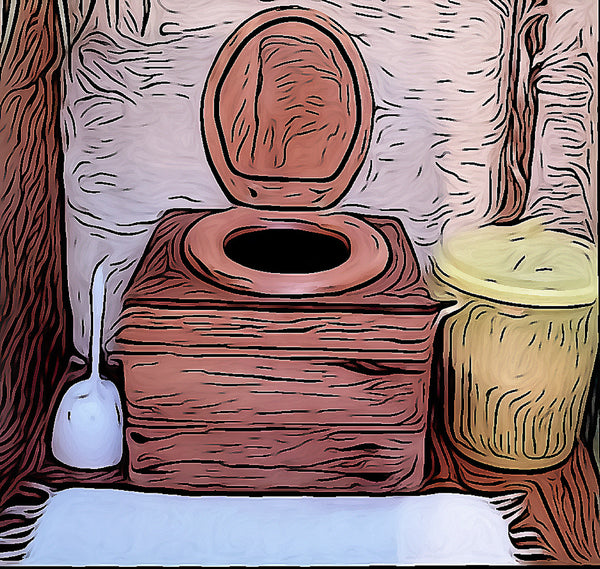
The classic batch toilet is often what people think of when they imagine a composting toilet. This type requires users to add a carbon-rich material, like sawdust or coconut fiber, after each use. This carbon addition helps maintain the right balance for aerobic (oxygen-based) bacterial breakdown, controlling odor and accelerating decomposition. Batch systems are simple, affordable, and often include urine diversion to manage moisture.
Chamber or Moldering Toilets
Similar to a batch system but with a larger chamber, these toilets need less frequent emptying and separate liquids from solids. Moldering toilets can handle more material, making them a good choice for stationary setups where maintenance is less convenient.
Split System Composting Toilets
A split system has two alternating chambers. When one chamber is full, it’s covered and left to compost while the other chamber is used. This design allows for longer composting times, helping to ensure materials are fully broken down before emptying. Split systems are often promoted as a simple, sustainable form of sanitation, especially in areas where full off-grid setups are in place.
This type of system was developed and promoted by ecosan and is one of the cheapest, safest and simplest forms of sustainable sanitation.
Self-Contained Composting Toilets
These compact toilets are popular for tiny homes, RVs, and boats because they’re easy to install and often come with helpful features like agitators and ventilation fans. Some models even use a small heating element to help dry out materials, especially in systems without a urine diverter. The fan and agitator combine to reduce odors and create a more user-friendly experience.
Central Composting Systems
In larger homes or shared spaces, central composting systems allow multiple toilets to connect to one central composting tank. Waste is transported via low-flush or vacuum-assisted systems to the central chamber, where it composts over time. With appropriately sized central units, maintenance is infrequent, typically once per quarter.
Each system has unique advantages, so your choice will depend on how often you want to maintain the toilet and the type of space you’re working with. If you’re intrigued, explore more in-depth on composting toilet systems.
Why Choose a Composting Toilet?
Composting toilets offer a variety of benefits that appeal to different lifestyles, from full-time vanlifers to eco-conscious homeowners. Here’s what makes them worthwhile:
- Cost Savings
Unlike traditional plumbing, composting toilets have minimal ongoing costs. You won’t need to pay water bills for flushing or buy chemical cartridges, saving you money over time. - Water Efficiency
Composting toilets use little to no water, saving an impressive 6,600 gallons per person each year. That’s good for the planet and your utility bill! - Eco-Friendly Solution
Composting toilets are environmentally friendly because they reduce water waste and minimize pollution from sewage. - Ideal for Remote and Off-Grid Locations
For cabins, tiny homes, RVs, boats, and emergency setups, composting toilets offer a flexible, sustainable option without relying on external infrastructure. - Gardening Benefits
After 6–12 months of composting, humanure (composted human waste) can be a valuable addition to your garden, enriching the soil and supporting plant growth.
Potential Downsides of Composting Toilets
No toilet is perfect, and composting toilets have their challenges. Here are a few to consider:
- Maintenance
Without a urine diverter, composting toilets may require more frequent emptying and additional carbon materials to keep things balanced. - Capacity Limitations
Smaller portable composting systems are great for travel or limited use but may need regular emptying. If you plan to compost in place, you’ll also need a safe space to let the composting process fully complete. - Manual Emptying
While composting toilets are convenient, they don’t “flush and forget.” Regular emptying is part of the experience, which may not appeal to everyone.
Despite these challenges, many users find the benefits of composting toilets far outweigh the downsides, especially when considering the environmental impact of traditional plumbing.
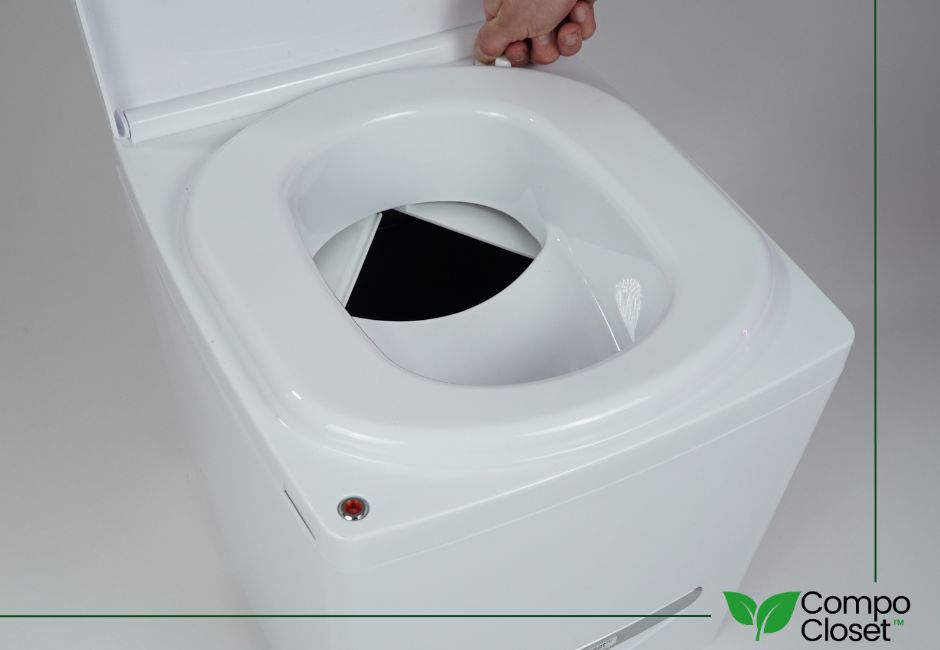
What is a Urine Diverter?
A crucial part of many composting toilets, a urine diverter separates liquids from solids, helping to prevent odors and making the toilet easier to empty. Most urine-diverting dry toilets (UDDTs) use a separator to keep solids and liquids apart, which is essential for odor control and simplifies emptying.
The separated urine can even be diluted and used as fertilizer for certain plants, or it can be disposed of in a connected drainage or sewer system. Because urine is largely sterile, it’s usually the solids that require careful handling due to pathogen content.
Fun Fact: Not all composting toilets feature urine diversion. Conversely, not all toilets with urine diversion are composting toilets! There are even low-flush toilets designed to divert urine as a water-saving feature.
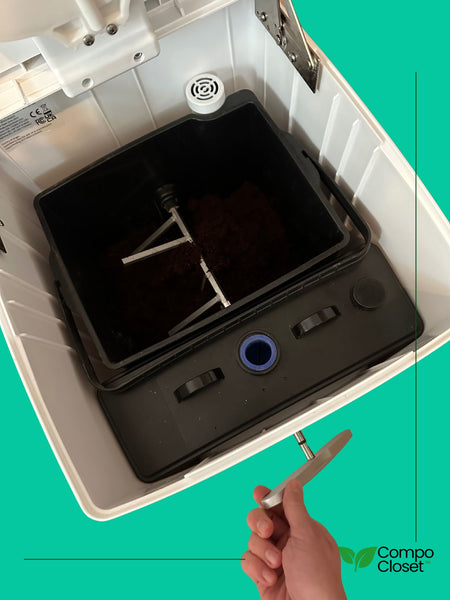
Composting Toilet Agitators
Agitators can make a big difference in a composting toilet’s effectiveness and ease of use. We designed our Cuddy toilet with an agitator, and here’s why it matters:
- Odor Reduction
Agitation promotes faster composting and ensures deposits are coated in carbon material, reducing odor effectively. - Space-Saving
With an agitator, all the carbon-rich bulking material can be added at once rather than after each use, freeing up storage space. - Convenience
Agitators make it simpler to mix materials without mess, reducing cleanup and allowing users to maintain the toilet without handling materials each time.
What a Composting Toilet is NOT
There’s a lot of confusion around composting toilets and other waste systems. Here’s a quick breakdown:
- Not a Bucket Toilet
While some bucket toilets can be upgraded with urine diversion or carbon material to begin composting, they typically don’t support the aerobic composting process. - Not a Pit Latrine
A pit latrine is just a hole in the ground, often used as a basic waste management system but lacking the aerobic conditions for true composting. - Not a Vermiculture Toilet
Vermiculture toilets use worms to break down waste, but the worms’ work is digestion, not composting. Composting, by definition, is an oxygen-driven process that turns organic material into stable, nutrient-rich humus.
Remember: A compost toilet does not completely treat human waste unless it is part of a composting system.

Are Composting Toilets Waterless?
Most composting toilets are waterless, also called “dry toilets.” They typically don’t flush and are often paired with a urine diverter. However, some water-assisted systems, like the Aquatron, use a small amount of water for flushing while separating liquids from solids—combining some benefits of flushing with composting capabilities.
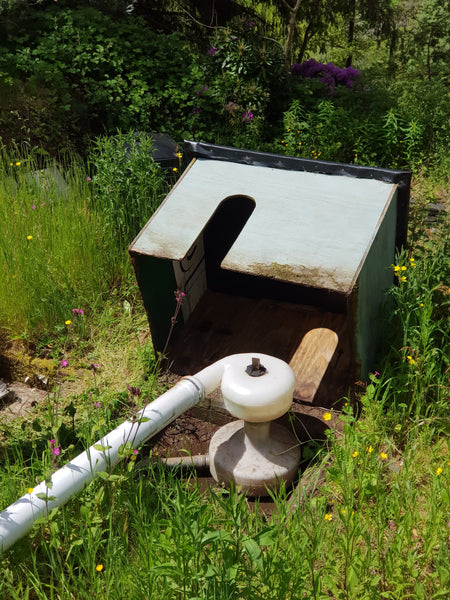
How to Empty a Composting Toilet with a Urine Diverter
Emptying your composting toilet depends on its design and usage, but here are general tips for managing both the liquid and solid chambers:
- Liquid Chamber: Empty the liquid container when it’s near full to prevent overflow. You can empty it into a standard sewer-connected toilet or in the wild, following local regulations on distance from animals and water sources.
- Solid Chamber: Most solid chambers need emptying once they’re full (like our Cuddy) or when the agitator becomes harder to turn (ex: a Nature's Head). For better handling, wait 8 hours after your last use to let decomposition begin.
Most areas allow securely bagged humanure to be disposed of in the trash, but if you prefer to use it for gardening, be sure to allow at least six months for proper composting.
What is Humanure? Composted Poop?

Humanure, or composted human waste, is a powerful soil amendment with many benefits. The composting process breaks down pathogens and stabilizes the material, creating a rich fertilizer that can enhance garden soil and reduce the environmental impact of waste disposal. Properly managed humanure composting is a sustainable practice with eco-friendly benefits.
For a deeper dive, check out The Humanure Handbook to learn more about the best practices for safe, sustainable composting.
Cleaning and Maintenance
Maintaining a composting toilet is easy. A simple rinse with vinegar and water is often enough for the liquid bin, and with a split system, the solids bin can be left as long as possible to compost before emptying. The low-maintenance design of toilets like the Cuddy allows for quick, hassle-free cleaning. Check out our Ultimate Cleaning Guide for more infos.
Where Can You Install a Portable Composting Toilet?
The flexibility of composting toilets makes them ideal for various settings. They’re a great option in RV bathrooms, campervans, sailboats, tiny homes, cabins, or even as a backup solution in off-grid scenarios. The portable design and self-contained systems mean you can take them on the road or set them up at home without needing a permanent installation.
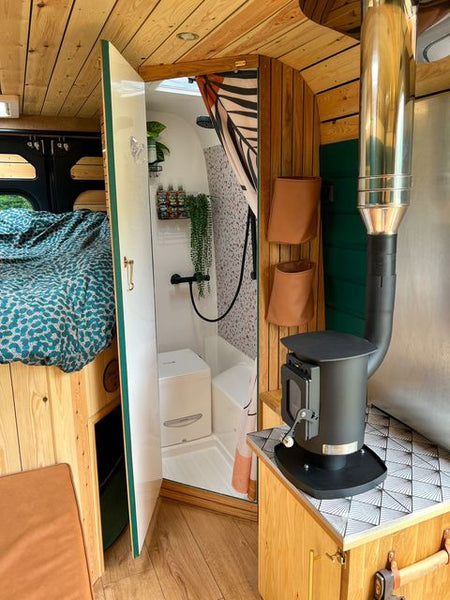
Summing It Up: What is a Composting Toilet?
To answer “What is a composting toilet?” in simple terms, it’s a waterless, eco-friendly toilet that treats human waste in conditions that encourage composting. Paired with a composting system, it can turn waste into a safe, nutrient-rich soil additive. As more people explore sustainable living, composting toilets are gaining popularity as an environmentally friendly alternative to traditional plumbing—ideal for homes, vans, cabins, and beyond.
If you’re ready to test the benefits of a composting toilet, check out our Cuddy models designed for convenience, low maintenance, and sustainable living.
0 comments



